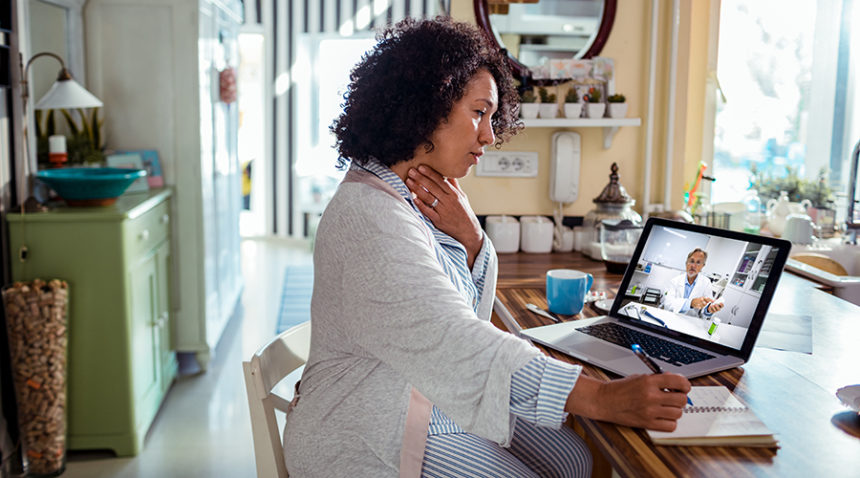Chances are good that you or someone in your family has received medical care virtually since the COVID-19 pandemic began in early 2020. Doctors in most specialties began offering virtual care via video calls to help prevent people from coming to clinics in person and potentially spreading the virus. About 1 in 5 adults in the U.S. had a telemedicine visit—conducted over video or phone—in the first half of December 2021.
But is virtual care here to stay, or is it a temporary tool to get us through the pandemic?
UNC Health allergist and immunologist Sofija D. Volertas, MD, hopes virtual care becomes a permanent part of healthcare.
“A video visit allows the doctor into your home. This may open up the door to healing in a way that is more effective than you might realize,” Dr. Volertas says. “I’m not saying it should replace in-person visits. It’s another tool in the toolbox.”
So when is an in-person visit best, and when is virtual care appropriate?
Deciding Between In-Person and Virtual Care
The best setting for a visit depends on the situation, Dr. Volertas says. What does a patient need to see a doctor about? Do both the doctor and patient have access to the necessary technology? Has the doctor seen this patient before?
Virtual care generally works well for allergy and immunology visits with her patients, Dr. Volertas says.
For some problems, she likes to see people first in person, with follow-up virtual visits. For other issues, such as drug allergies, she likes to start with a virtual visit to gather the person’s history and then do follow-up testing in person.
During virtual visits, Dr. Volertas can talk with patients about how well their symptoms are being controlled and whether there are side effects to medications. She can see patients in their home environments and may spot some allergy and asthma triggers, such as multiple pets, open windows or incense.
“I see patients who live hours away, at the coast or in the mountains, who can’t make regular visits to our office in Chapel Hill,” she says.
Eventually, patients may be able to link their personal devices to their providers’ systems to track blood oxygen levels, sleep patterns, heart rates and other data.
“We have attachments for our cellphones that can look in ears and help diagnose an ear infection at home,” Dr. Volertas says, “and attachments that can listen to people’s lungs.”
Virtual care allows for the existence of hospital-at-home programs, such as UNC Health’s Advanced Care at Home, which can be very beneficial for patients who are able to heal from illness in their own homes.
Virtual Care Can Improve the Doctor-Patient Relationship
It might seem counterintuitive, but video visits can promote a stronger connection, Dr. Volertas says. They are the new “house call.”
“I, too, believe in the power of the physical exam, the power of a healing handshake or hug,” she says. “But what I have realized is that if doctors are not relying on the in-person exam in a telehealth visit, then we’re forced to really listen to get our information.”
When a patient is in the clinic, the doctor may be looking at a computer screen with lab test results or X-rays displayed. Doctors may have their backs to the patient, allowing technology to become a barrier to connection. Virtual visits require doctors to develop their “webside manner” in addition to their bedside manner, Dr. Volertas says.
“Human connection is the root of healing,” she says, “and telemedicine improves the human connection.”
Potential Advantages of Telehealth
Virtual care has been a useful tool during the pandemic that can be adapted in the years to come. Here are some of the benefits:
- Patients have the option to receive medical care even if they are afraid to come into a clinic.
- Patients can save time and money by avoiding travel time, parking, the need for child care and extra time away from work.
- Healthcare providers can see a patient in his or her own environment and better understand if something at home is contributing to illness or causing additional stress.
- Virtual care allows more frequent interactions with a healthcare provider to monitor specific issues, including blood pressure and blood oxygen levels (taken with at-home equipment), medication side effects, diet and behavior modification.
- Providers get more time to listen to their patients.
- Patients and clinics have an opportunity to use technology that comes with many cellphones, Apple Watches, Fitbits and other devices that monitor health.
Potential Disadvantages of Telehealth
Of course, virtual care will not replace all in-person visits with a healthcare provider. Here are a few reasons why:
- Not everyone has a device to use for a telemedicine visit, and many people don’t have access to reliable internet service.
- Patients might not be able to find a quiet, private place in their homes for a confidential conversation with a healthcare provider.
- Some people are not prepared to troubleshoot computer problems if they arise. Connection problems can lead to stress and frustration.
- Some patients are not comfortable with being on video.
- Some insurance companies do not fully reimburse for telehealth visits, which might add a financial burden for patients.
“Certainly, there are times when in-person visits are best,” Dr. Volertas says. “But telehealth is a tool that may allow us to tap into the human connection in ways we’ve never been able to do in the clinic.”
Learn more about virtual care from Dr. Volertas’ TEDx talk.
If you need to be seen by your primary care physician for routine care, ask if virtual visits are an option. If you don’t have a primary care physician, find one near you. Learn more about Virtual Care Now at UNC Health, which is available 7 days a week, 365 days a year, from 6 a.m. to 10 p.m.

